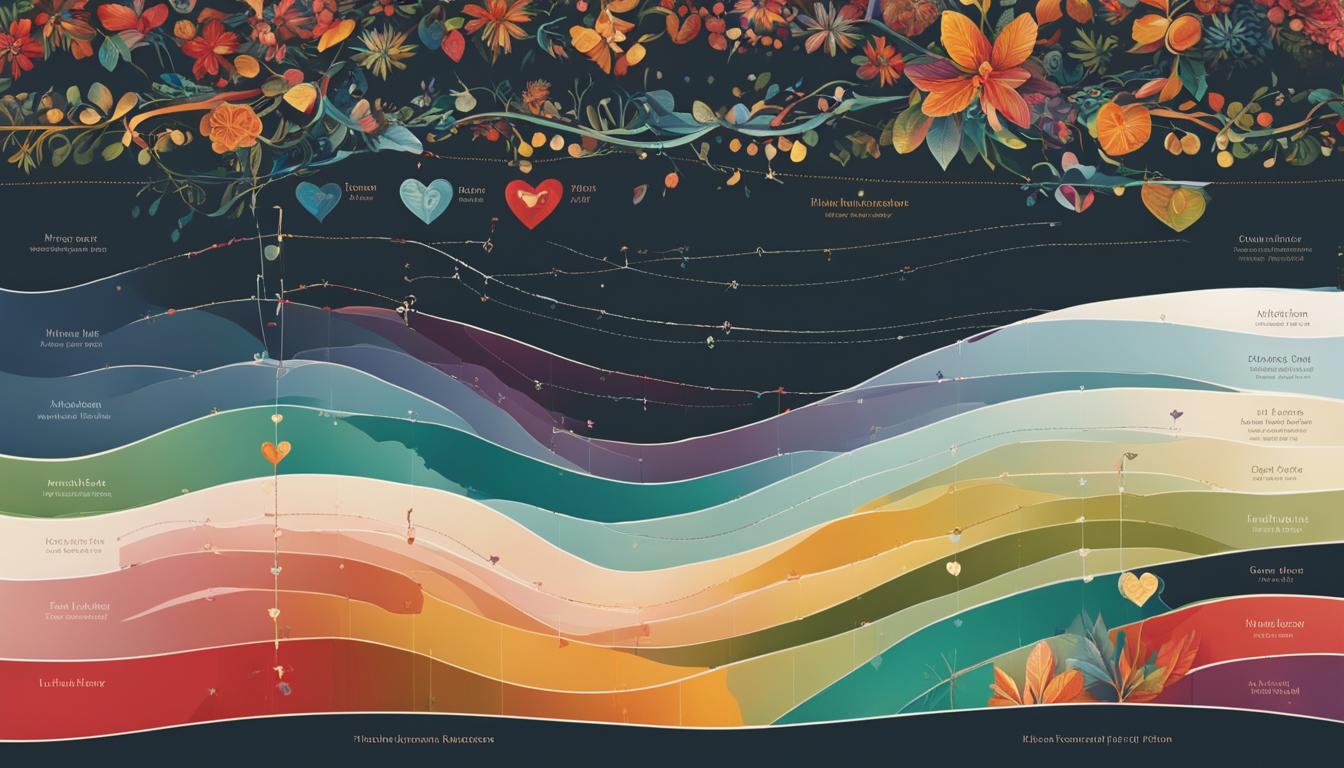Have you ever wondered how long a long-term relationship lasts? Or what the different stages of a relationship are? Understanding the timeline of a long-term relationship can provide valuable insights into the dynamics and challenges that couples may face along the way.
According to experts in love, there are four stages that most relationships go through: the euphoric stage, the early attachment stage, the crisis stage, and the deep attachment stage. Each stage has a specific duration, although it’s important to note that these timelines can vary depending on individuals and circumstances.
So, how long is a long-term relationship? Let’s delve into the timeline of these stages to find out.
Key Takeaways:
- The timeline of a long-term relationship consists of four stages: the euphoric stage, the early attachment stage, the crisis stage, and the deep attachment stage.
- The duration of each stage may vary based on individual circumstances.
- Understanding the stages of a relationship can help couples navigate the ups and downs of their journey together.
- The timeline provides a general guideline, but additional stages and landmarks may also exist.
- By recognizing the characteristics and milestones of each stage, couples can better understand their own relationship and work towards maintaining a strong and fulfilling connection.
Navigating the Stages of a Relationship
In the early stages of a relationship, couples often experience a decrease in negative judgment towards each other, a sign of a long-term relationship. This shift in perspective is linked to relationship success, as it fosters a more positive and supportive dynamic. As the initial euphoric stage extends beyond the typical timeline for some couples, they enjoy an extended period of excitement and infatuation.
However, as the relationship progresses, couples transition into the early attachment stage. During this phase, they begin to establish routines, build a shared life, and make plans for the future. It is a time when partners become more familiar with each other’s habits, preferences, and quirks. While the initial intensity of the relationship may subside, this stage allows couples to deepen their bond, enhance their emotional connection, and focus on other aspects of their lives together.
Keeping Love Alive in the Long Term
Building a strong and lasting relationship requires effort and commitment from both partners. While the initial stages of a relationship may be filled with excitement and passion, maintaining the spark in the long term can be a challenge. Fortunately, researchers have identified some factors that contribute to successful long-term relationships and the secrets to keeping love alive.
“Novelty and new experiences are key to maintaining a strong long-term relationship,” suggests Dr. Rachel Adams, a renowned relationship expert. Engaging in new and challenging activities together can inject freshness and excitement into the relationship. Whether it’s trying out a new hobby, going on an adventure, or simply exploring new places, shared experiences can strengthen the bond between partners.
“Couples who actively seek out new experiences together often have a higher level of relationship satisfaction,” says Dr. Adams. “It’s about breaking the routine and creating new memories.”
In addition to seeking novelty, another secret to a successful long-term relationship is the ability to suspend negative judgment towards each other. Over time, it’s natural for couples to have disagreements or experience rough patches. However, being able to approach these challenges with understanding and empathy is crucial.
“Instead of harboring negative feelings or dwelling on past grievances, couples should focus on rekindling the positive aspects of their relationship,” advises Dr. Adams. “Remember what made you fall in love in the first place and find ways to reignite that spark.”
By nurturing a sense of adventure and prioritizing positive interactions, couples can build a strong foundation for their long-term relationship. The key is to embrace new experiences together and cultivate understanding, allowing love to thrive in the face of challenges.

So, whether you’re embarking on a new relationship or are already in a long-term commitment, remember these secrets to building a strong and lasting connection. Prioritize shared experiences, seek novelty, and keep the flames of love burning bright.
The Phases of a Relationship Beyond the Timeline
While the four stages mentioned earlier provide a general timeline for a long-term relationship, there are additional stages and landmarks that couples may experience. These stages can be non-linear and may vary based on individual circumstances. Understanding these additional stages can help you navigate the complexities of your relationship and appreciate its unique journey.
One additional stage of a relationship is the growth and exploration stage. This phase occurs when couples have built a strong foundation and are ready to explore new aspects of their relationship. It may involve trying new hobbies together, embarking on adventures, or pursuing common goals.

During this stage, couples often discover new dimensions of their bond, fostering deeper intimacy and mutual understanding. It is an opportunity for personal growth and mutual support as you face challenges and celebrate achievements together.
Another important stage is the adversity stage. This phase occurs when couples face significant challenges or external stressors that test their relationship. It could be financial difficulties, health issues, or the loss of a loved one.
H3: Coping with Challenges during the Adversity Stage
This stage requires open communication, empathy, and a shared effort to overcome adversities. It is an opportunity for couples to come together, strengthen their resilience, and build an even stronger bond.
Finally, there is the commitment stage. This stage occurs when couples make long-term commitments to each other, such as getting engaged, moving in together, or getting married. It is a significant milestone that solidifies the commitment and deepens the sense of partnership.
Recognizing these additional stages and landmarks in your relationship can help you appreciate the complexity and depth of your bond. Each stage brings its own set of challenges and rewards, contributing to the overall growth and fulfillment in a long-term relationship.
Conclusion
Understanding the stages of a long-term relationship and the duration of each stage is crucial for couples who want to maintain a strong and fulfilling connection. By recognizing the characteristics and milestones of each stage, you can navigate the ups and downs of your journey together with clarity and purpose.
Throughout your relationship, you will experience the euphoric stage, where everything feels magical and effortless. Then, you will transition into the early attachment stage, where you build a deeper bond and start to integrate your lives. As time goes on, you may encounter challenges that characterize the crisis stage, but with resilience and communication, you can overcome them and enter the deep attachment stage.
To maintain a strong relationship in the long term, it is essential to prioritize novelty and new experiences. Engaging in fresh and exciting activities together will inject passion and excitement into your daily lives. Additionally, suspending negative judgment and revisiting the early stages of your relationship can reignite the flame and foster intimacy.
Remember, every couple’s journey is unique, and the stages mentioned here provide a general framework. Your relationship may follow a different timeline, and that’s perfectly fine. What matters most is your commitment to understanding, supporting, and nurturing each other through the various stages of your long-term relationship.
FAQ
How long is a long term relationship?
The duration of a long-term relationship can vary greatly depending on the individuals involved. On average, a long-term relationship is considered to be one that lasts for at least two years or more.
What are the stages of a long-term relationship?
The stages of a long-term relationship are the euphoric stage, the early attachment stage, the crisis stage, and the deep attachment stage. Each stage has its own characteristics and duration.
What are the signs of a long-term relationship?
Signs of a long-term relationship can include a deep emotional connection, trust, commitment, shared goals, effective communication, and mutual respect. These are often indicators of a strong and lasting bond.
How can I maintain a long-term relationship?
Maintaining a long-term relationship requires effort from both partners. Key factors include effective communication, spending quality time together, keeping the romance alive, resolving conflicts respectfully, and supporting each other’s individual growth.
What are the secrets to a long-term relationship?
Some secrets to a long-term relationship include understanding and accepting each other’s flaws, prioritizing intimacy and passion, being open and honest, practicing forgiveness, and continuously nurturing the relationship.
What are the additional stages of a relationship?
In addition to the four stages mentioned earlier, couples may experience stages like the power struggle stage, the stability stage, the growth stage, and the commitment stage. These stages can occur at different times and may vary in duration for each couple.
What are relationship landmarks?
Relationship landmarks are significant events or milestones that occur within a long-term relationship. Examples can include moving in together, getting engaged, getting married, having children, and celebrating anniversaries. These landmarks often hold personal meaning for each couple.
How can understanding the stages of a long-term relationship benefit a couple?
Understanding the stages of a long-term relationship can help couples navigate the challenges and changes that come with time. It allows them to anticipate potential issues, seek support when needed, and make conscious efforts to maintain a strong and fulfilling connection.
Source Links
- https://www.shape.com/lifestyle/sex-and-love/stages-of-a-relationship
- https://www.womenshealthmag.com/relationships/a42477991/stages-of-a-relationship/
- https://www.verywellmind.com/the-four-stages-of-relationships-4163472


